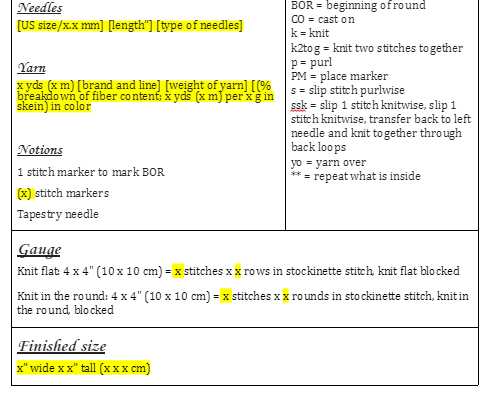
Use a template to design knitting patterns
I'm all for systems and processes that will make life easier, so I try to make templates for just about everything. When I get a request from a new designer to tech edit their pattern, typically my response is a templated response I have saved in Gmail, with some minor alterations. I have my invoices saved as a template in PayPal too so that I don't have to put my business info and rate in every time I create a new invoice. The list goes on. Templates just make life so much easier.
And you can do this to your patterns too. You may be asking: what is the difference between a template and a style sheet? How I see it is a style sheet is a document with every possible note you may need to use when designing future patterns and making sure everything conforms to your style. A template is basically an empty version of my pattern that I can fill in with details.
What to include on your pattern sales page
You may know that I hosted the Scrappy Project MAL a few months ago to encourage myself and others to knit from our stashes. It's good for the environment and your wallet, and you can create something out of yarns you never would have thought to pair together.
As I was looking for patterns to knit, I spent time on a lot of pattern pages on Ravelry and it got me thinking about what I like to see on that page as a knitter when I’m browsing. When I was shopping for a pattern, there were specific things I needed to know, and if that info wasn't there, I'd just move on.
So what should designers include?
UX design in knitting patterns
Big companies spend a lot of money investing in user experience. In the world of software development, there is a role called the user experience (UX) designer. According to Glassdoor, UX designers are “responsible for enhancing customer satisfaction by improving the usability, accessibility, and pleasure associated with a product in a way that is attractive and convenient for users.”
And with an average salary of $97,500 (with more experienced designers earning possibly up to $157,000 per year), it’s clear this is a highly valuable skill.
Though as an independent knitwear designer you may not have the cash to shell out to hire someone to do this sort of work, you can still think about how your pattern layout and instructions impact your users. Remember, happy knitters might be return knitters, and the opposite is true too. If your pattern is confusing and hard to follow, knitters may never buy from you again because they remembered how frustrating it was the first time.
Editing Google Docs vs PDFs
When I first started tech editing I decided I would only accept PDFs. It’s what was taught in the tech editing course I took so I just went with it.
But then someone sent me a Google Doc and I realized I actually liked editing in it, too.
What file type you like to edit can be a big debate among tech editors. Whenever preferred editing software comes up, everyone tends to get very opinionated. I tend to like both, and think there are upsides and downsides to both.
Why you should stay in touch with your tech editor during testing
Tech editing is often completed before the pattern testing process begins. You design your pattern, you send it off to your editor, and once they’ve made all their edits, it’s ready to be sent off to testers, before finally being published.
But just because the tech editing process is over doesn’t mean you should stop communication with your tech editor!
Why the conversion rate from inches to cm is different in the knitting world than the real world
Typically when you need to convert inches to cm, you can just multiply the number of inches by 2.54 because that is the number of centimeters in a single inch. But if you follow this standard math rule in your knitting patterns, it’ll lead to some trouble.
In knitting, we need to use a conversion rate of 2.5 instead in order to get the right numbers. Why is this? Well, think of how gauge is listed on a pattern. Gauge is most often given in a 4 x 4″ or 10 x 10 cm square. But actually if you were to convert those 4 inches to cm using the 2.54 rate, you’d end up with a gauge swatch that is 10.16 x 10.16 cm. Not exactly easy to count stitches/rows to the decimal like that. So rather than making knitters grab their magnifying glasses to measure how many stitches/rows are in 10.16 cm, we round down to an even 10, and then have to alter the conversion rate to match a ratio of 4:10, which is 2.5.